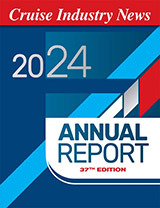“Things are going very well for 2009,” said a predictably upbeat Rick Sasso, chairman of the Cruise Lines International Association (CLIA) marketing committee and president and CEO of MSC Cruise USA, speaking at CLlA’s annual state of the industry press conference in New York last Wednesday. He added, “things are looking very bright for 2009 and beyond, and there are clear skies and calm seas ahead.”
Sasso said he was citing travel industry experts and CLIA’s recent survey of travel agents, which showed that 92 percent expressed optimism when looking ahead over the next three years. Sasso also cited Expedia Cruiseship Centers, which has reported year-end growth of 18 percent with sales and bookings of $310 million, and 2009 bookings 14 percent ahead of this time last year; as well as reports that Princess Cruises has seen record bookings over the past few days.
CLIA’s forecast is for 13.5 million passengers for 2009, including 3. I million sourced from outside of the U.S. An estimated 13.2 million cruised in 2008, up from 12.56 million in 2007.
Sasso also said that “if I were to speculate, I would expect more new ships to be ordered for 2012.” He said there are 10 new ships joining the CLIA lines in 2010, seven in 2011 and four in 2012.
(According to Cruise Industry News, industry wide, 11 new ships will enter service in 2009; 14 in 2010; 8 in 2011 and five in 2012.)
Trends
Sasso noted that current industry trends are characterized by what he called attractive pricing; shorter booking windows, increased international sourcing, and an expansion of groups and meetings.
He said the industry has been on a continuous growth course since 1980, averaging an annual growth rate of 7.4 percent, despite the 1982 oil crisis, the 1990 recession and 9/ 11. According to Sasso the growth drivers have been value, variety (of product and destinations) and supply.
Sasso also noted that when some cruise lines have started to charge for room service and other amenities, it is partially an effort to reduce waste. He said some passengers abuse complimentary services.
ln addition, while the bigger ships carry more passengers, he said, they also offer a much better space ratio than ships did just 15 years ago. Passengers are not only getting more space but also more services and activities, and ticket fares tend to be lower. So since passengers are getting four times more than they were, Sasso said, it is only fair that lines try to balance the economic picture a little.
As for onboard spending and shops, he said shopping is part of the passenger entertainment experience, including the art auctions, which Sasso described as very enjoyable.
Sasso made the point that whatever products or services passengers buy on a cruise ship, they cost less onboard, including drinks, than what they would cost at a land-based resort.
Uncertain Environment
‘There is no doubt that 2009 represents an uncertain environment, not only for CLlA members but for all industries and consumers alike,” commented Terry Dale, CLlA’s president and CEO, who was also at the NYC event along with Bob Sharak, executive vice president of marketing and distribution.
“The remarkable diversity and variety of cruises give consumers a unique opportunity to find a vacation that fits their budget even during these economic downturns, and we expect that North Americans, Europeans and travelers from all over the world will respond positively.”
CLIA ‘s 2009 forecast for 13.5 million passengers breaks down as I 0.4 million Americans and 3.1 million from outside the U.S., mostly Europe. When Costa Crociere and MSC’s fleets are included with an estimated 2009 capacity of some 1.85 million, that leaves 1.25 million foreign-sourced passengers for the North American fleet, or about 11 percent of its total capacity.
In a prepared statement, CLlA also pointed to the industry’s impact on the American economy, claiming an economic output of $38 billion for 2007. Direct spending in the U.S. in 2007 on goods and services was more than $18 billion.
CLlA has 23 member lines, including small-ship and riverboat companies, with 185 ships, which it said represents 97 percent of North American cruise capacity, and 16,000 travel agencies, as well as individual travel agent members.



